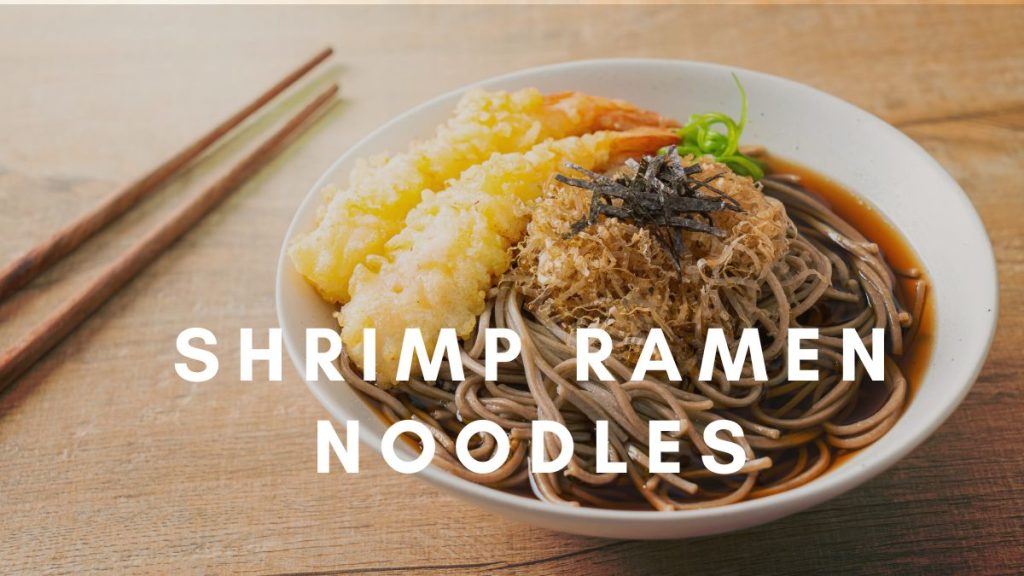I’ve always been a big believer that the best recipes are the ones that offer a fantastic base with plenty of room to get creative. That’s the magic of Shrimp Ramen Noodles! It’s a dish that’s satisfying on its own, yet acts as the perfect canvas to try out different flavor combos and suit anyone’s tastebuds. Plus, it’s easy to whip up on a busy weeknight or when you’re short on time.
[toc]
Key Takeaways
- Shrimp and ramen are a super versatile combo that’s perfect for tasty, quick, and customizable meals.
- Choose the ramen and shrimp type that works best for you – fresh ramen is amazing, but instant is perfectly delicious too.
- Don’t be afraid to experiment with different flavor profiles, from spicy to nutty to classic comfort food vibes.
The Essential Ingredients

- Ramen Noodles: You’ve got options here. Fresh ramen noodles have that unbeatable chewy texture, but the familiar instant ramen packs are an awesome, budget-friendly choice. Don’t sweat the seasoning packet – we’ll be making our own flavorful sauce!
- Shrimp: Fresh or frozen will do. If frozen, be sure to thaw them properly. Size-wise, medium to large shrimp usually work best for this kind of dish.
- The Flavor Base: The heart of the dish! Garlic and ginger are classics, while soy sauce, sesame oil, rice vinegar, and a touch of chili heat add depth.
- Veggies: Get creative! Broccoli, bell peppers, onions, snow peas, carrots… the list is endless. Think about textures and flavors you enjoy.
Shrimp and Ramen Cooking Techniques
Shrimp and Ramen Cooking Techniques: Mastering the Basics
There’s something truly satisfying about a perfectly cooked shrimp and ramen dish. That tender, juicy shrimp, the flavorful broth, those springy noodles… it’s a symphony of textures and tastes. But how do you nail that perfect execution? Let’s break down two classic methods:
Stir-Frying: The Path to Flavor Town
I love the stir-fry method because it’s all about speed and that incredible caramelization you get on the shrimp. Here’s the gist:
- Heat Things Up: Get a wok or large skillet sizzling hot with a touch of neutral oil. You want to hear that oil crackle when you add your ingredients!
- Garlic and Ginger Party: Sauté these aromatics for just 30 seconds, until they release their wonderful fragrance.
- Shrimp Time: Toss those shrimp in, aiming for a single layer in the pan. Let them sear for 1-2 minutes per side, just until they turn pink and slightly opaque. Don’t overcook, or they’ll become rubbery!
- Veggie Fun: Now’s the time for your veggies. Quick-cooking ones like bell peppers and snow peas are perfect. Sauté them briefly, just until they get a little crisp-tender.
- Sauce It Up: Pour in your sauce, whether it’s a classic soy sauce and sesame oil mixture or something more adventurous. Let it bubble and reduce slightly.
- Noodle Nest: Add your cooked ramen noodles directly to the pan and toss everything together. The noodles will soak up that delicious flavor.

Boiling/Poaching: A Gentle Approach
This method is fantastic for a lighter broth and super tender shrimp. Think of it like a flavorful shrimp noodle soup:
- Broth is Boss: Start with a flavorful broth as your base – chicken, vegetable, or a simple bouillon with aromatics. Bring it to a simmer.
- Shrimp Dip: Gently add your shrimp to the simmering broth. Cook for just 2-3 minutes, or until they turn pink and curl into a “C” shape. Don’t let it boil, or the shrimp will get tough.
- Noodle Time: Add your cooked ramen noodles directly into the pot. They’ll just need a minute or so to warm through.
- Flavor Boost: Before serving, give the dish a taste and adjust the seasoning. Maybe a splash of soy sauce, a squeeze of lime, or a sprinkle of herbs.
Flavor Infusion
No matter your cooking method, let’s think about building flavor throughout the process. Sautéing your aromatics (garlic, ginger) is the first step. Then think about when to add the shrimp and veggies relative to your sauce ingredients for optimal flavor absorption.
Creative Variations for Your Shrimp and Ramen
Now, this is where things get really fun. Let’s explore some tasty variations on this theme:
- Classic Comfort: Think a creamy broth with tender shrimp, a touch of garlic, and plenty of fresh herbs.
- The Spicy Kick: Sriracha, chili flakes, or your favorite hot sauce take this dish to another level.
- Peanut Power: Peanut butter, a little soy sauce, lime, and a touch of sweetness create an incredibly satisfying sauce.
- Going Green: Load up on veggies for a colorful, veggie-packed ramen bowl.
Serving Suggestions and Toppings
The finishing touches can really elevate your shrimp and ramen. Let’s talk about adding that extra oomph:
- Garnishes: Fresh cilantro, thinly sliced green onions, and a generous sprinkle of sesame seeds add color and vibrancy. A squeeze of lime wedge delivers a zesty pop!
- Something Crunchy: Fried shallots, toasted nuts, or even crumbled-up ramen seasoning packets can add a delightful textural contrast.
- Spice it Up: Keep a jar of chili oil or your favorite hot sauce on the table for those who like it extra fiery.
Side Dishes
Shrimp and ramen can be a satisfying meal on its own, but a side dish or two can complete the experience:
- Fresh and Light: A simple Asian-inspired cucumber salad adds freshness.
- Crispy Counterpoint: Potstickers or pan-fried dumplings make a fantastic pairing.
- Simple and Savory: Steamed edamame with a sprinkle of salt is always a crowd-pleaser.
Tips and Tricks for the Perfect Shrimp and Ramen
Let’s make those shrimp and ramen dreams a reality! Here are some handy tips:
- Noodle Know-How: To avoid mushy noodles, be sure to follow package instructions or cook them until just al dente. Rinse them with cold water to stop the cooking process if making them ahead of time.
- Perfectly Cooked Shrimp: Shrimp cooks fast! Overcooked shrimp get rubbery, so keep a close eye on them. They’re done when they turn pink and curl into a “C” shape.
- Make it Ahead: You can chop veggies and make your sauce in advance. Store in sealed containers in the fridge, leaving the final cooking and assembly for later.
- Flavor Boosting: Taste your dish as you go! You may want to add a splash more soy sauce, a hint of sweetness, or an extra kick of heat.
Customization is Key
The greatest thing about this dish is how easily you can make it your own. Here’s what I mean:
- Protein Swaps: Tofu, chicken, or even thinly sliced beef can be used instead of shrimp.
- Up the Veggie Factor: Mushrooms, spinach, bok choy… let your fridge be your guide!
- Broth or No Broth: If you want more sauce than broth at the end, simply reduce the amount of liquid you use at the start.
- Experiment with Flavors: Curry paste, a splash of coconut milk, lemongrass… get creative and try something new!
Let’s Talk Tables
Here’s a table to help you choose the right ramen for your needs:
| Ramen Type | Texture | Best For |
|---|---|---|
| Fresh | Chewy, springy | Authentic flavor, special occasions |
| Instant | Softer, familiar | Budget-friendly, quick meals |
| Gluten-Free | Often rice-based | Dietary restrictions |
And a quick table on some great veggie additions:
| Vegetable | Prep | Flavor/Texture |
|---|---|---|
| Broccoli | Cut florets | Mild, slightly crunchy |
| Bell Peppers | Thin slices | Sweet, vibrant |
| Carrots | Julienne or grated | Adds sweetness, color |
| Snow Peas | Trim ends | Sweet, crisp |
FAQs
Can I use frozen shrimp for this recipe?
Absolutely! Thaw the shrimp overnight in the fridge for the best results. If you’re short on time, you can thaw them quickly in a bowl of cold water. Just be sure to pat them dry before cooking.
Is there a substitute for ramen noodles?
Yes, there are options! Rice noodles, soba noodles, or even zucchini noodles (for a low-carb option) can work well in this kind of dish.
How can I make this dish healthier?
Here are a few ideas:
Use whole-wheat ramen noodles for extra fiber.
Increase the proportion of vegetables to noodles.
Opt for light or low-sodium soy sauce.
Consider baking or air-frying your shrimp instead of stir-frying for less oil.1
What if I don’t have [a specific ingredient]?
If you’re out of ginger, use a little ground ginger.
No rice vinegar? A splash of white wine vinegar or lemon juice works in a pinch.
Swap out any veggies you don’t have for ones you already have on hand.
Can I make this vegetarian/vegan?
Of course! Swap the shrimp for firm tofu or your favorite plant-based protein. Be sure to choose a vegetable broth and adjust any sauces to be vegan-friendly.
Shrimp Ramen Noodles Conclusion
Whether you’re a seasoned cook or just starting to explore the kitchen, shrimp and ramen noodles offer endless possibilities.
It’s a fantastic dish for busy weeknights, budget-friendly meals, or simply those moments when you crave something warm, flavorful, and easy to whip up.
Don’t be afraid to make this recipe your own. Experiment with different flavor profiles, add your favorite veggies, and play around with toppings. Remember, cooking should be fun and a way to express your creativity.




1 thought on “Shrimp Ramen Noodles: CRAZIEST Meal EVER?”